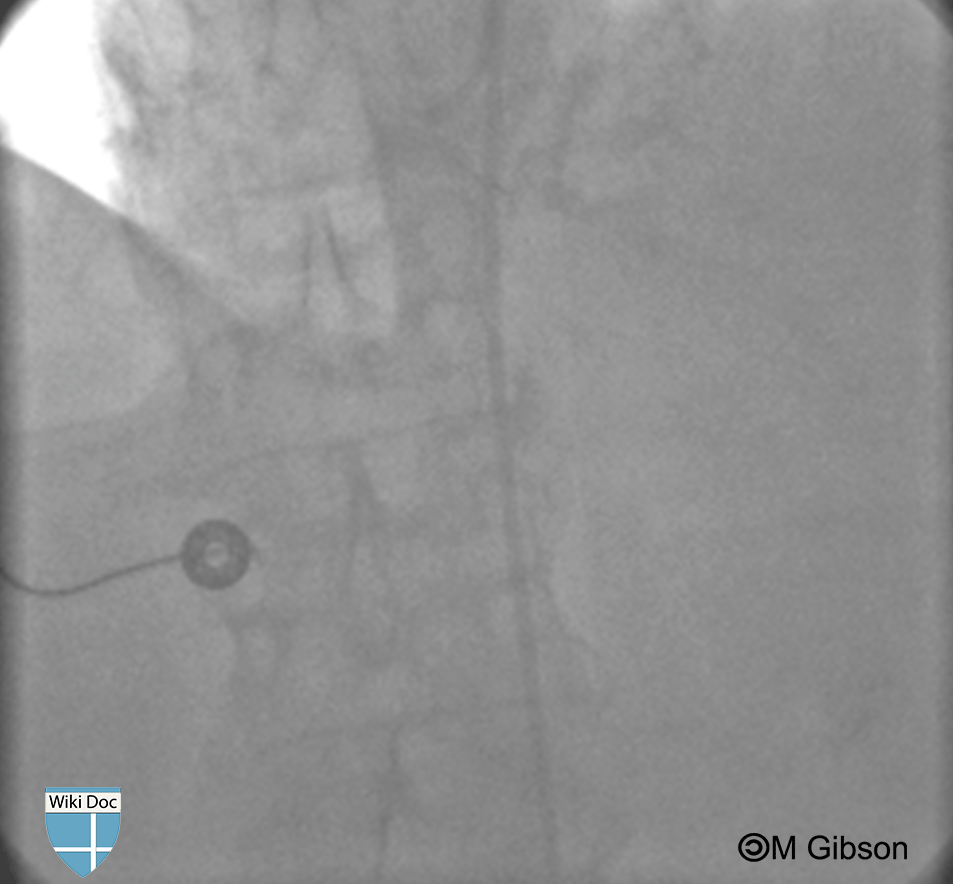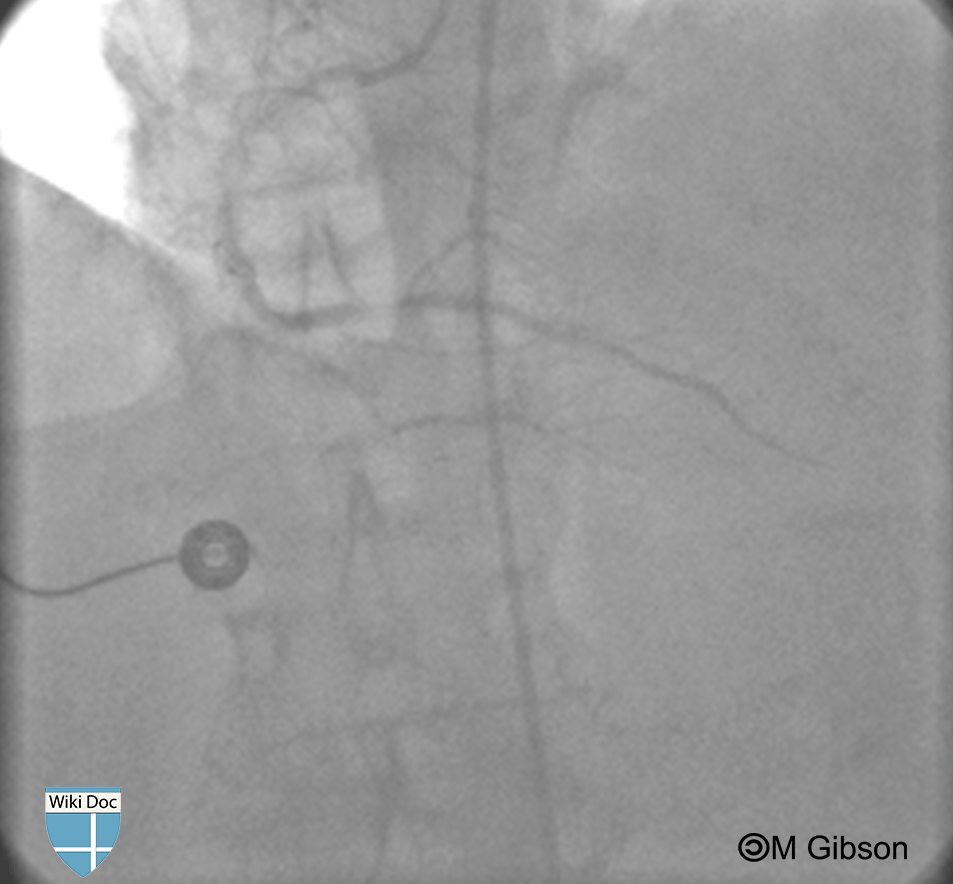Coronary artery calcification: Difference between revisions
Rim Halaby (talk | contribs) |
Rim Halaby (talk | contribs) No edit summary |
||
| Line 5: | Line 5: | ||
The [[coronary angiogram]] is fairly insensitive to the presence of [[lesion]] [[calcification]], particularly the presence of deep [[vessel]] wall [[calcification]]. [[Intravascular ultrasound]] is much more sensitive in the assessment of [[vessel]] wall [[calcification]]. Conventional [[coronary angiography]] has limited [[sensitivity]] for the detection of smaller amounts of [[calcium]], and has moderate [[sensitivity]] for the detection of extensive [[lesion]] [[calcium]] ([[sensitivity]] 60% and 85% for three- and four-quadrant [[calcium]], respectively).<ref name="pmid7895353">{{cite journal |author=Mintz GS, Popma JJ, Pichard AD, ''et al.'' |title=Patterns of calcification in coronary artery disease. A statistical analysis of intravascular ultrasound and coronary angiography in 1155 lesions |journal=Circulation |volume=91 |issue=7 |pages=1959–65 |year=1995 |month=April |pmid=7895353 |doi= |url=}}</ref> [[Calcification]] is often associated with older [[graft]] age, [[insulin–dependent diabetics]], and [[smoking]].<ref name="pmid15723972">{{cite journal |author=Castagna MT, Mintz GS, Ohlmann P, ''et al.'' |title=Incidence, location, magnitude, and clinical correlates of [[saphenous vein graft]] [[calcification]]: an intravascular [[ultrasound]] and [[angiographic]] study |journal=Circulation |volume=111 |issue=9 |pages=1148–52 |year=2005 |month=March |pmid=15723972 |doi=10.1161/01.CIR.0000157160.69812.55 |url=}}</ref> [[calcification|Calcified]] [[lesion]]s pose several challenges to the [[interventional cardiologist]]s as they are sometimes difficult to cross with the [[angioplasty]] equipment, they are less likely to fully dilate, they are prone to recoil, and they often do not allow for full expansion of the [[stent]]. Failure to fully expand the [[stent]] may result in [[restenosis]]. [[Stents]] should be deployed only after ensuring that the [[lesion]] can be fully expanded by a conventional balloon [[angioplasty]]. | The [[coronary angiogram]] is fairly insensitive to the presence of [[lesion]] [[calcification]], particularly the presence of deep [[vessel]] wall [[calcification]]. [[Intravascular ultrasound]] is much more sensitive in the assessment of [[vessel]] wall [[calcification]]. Conventional [[coronary angiography]] has limited [[sensitivity]] for the detection of smaller amounts of [[calcium]], and has moderate [[sensitivity]] for the detection of extensive [[lesion]] [[calcium]] ([[sensitivity]] 60% and 85% for three- and four-quadrant [[calcium]], respectively).<ref name="pmid7895353">{{cite journal |author=Mintz GS, Popma JJ, Pichard AD, ''et al.'' |title=Patterns of calcification in coronary artery disease. A statistical analysis of intravascular ultrasound and coronary angiography in 1155 lesions |journal=Circulation |volume=91 |issue=7 |pages=1959–65 |year=1995 |month=April |pmid=7895353 |doi= |url=}}</ref> [[Calcification]] is often associated with older [[graft]] age, [[insulin–dependent diabetics]], and [[smoking]].<ref name="pmid15723972">{{cite journal |author=Castagna MT, Mintz GS, Ohlmann P, ''et al.'' |title=Incidence, location, magnitude, and clinical correlates of [[saphenous vein graft]] [[calcification]]: an intravascular [[ultrasound]] and [[angiographic]] study |journal=Circulation |volume=111 |issue=9 |pages=1148–52 |year=2005 |month=March |pmid=15723972 |doi=10.1161/01.CIR.0000157160.69812.55 |url=}}</ref> [[calcification|Calcified]] [[lesion]]s pose several challenges to the [[interventional cardiologist]]s as they are sometimes difficult to cross with the [[angioplasty]] equipment, they are less likely to fully dilate, they are prone to recoil, and they often do not allow for full expansion of the [[stent]]. Failure to fully expand the [[stent]] may result in [[restenosis]]. [[Stents]] should be deployed only after ensuring that the [[lesion]] can be fully expanded by a conventional balloon [[angioplasty]]. | ||
== | ==Grading System== | ||
* None: no radiopacity. | * None: no radiopacity. | ||
| Line 16: | Line 16: | ||
==Angiography Examples== | ==Angiography Examples== | ||
Shown below are an animated image and a static image depicting calcification in the right coronary artery. Encircled in yellow in the image on the right is the calcified lesion. Note the haziness in the calcified lesion. | |||
[[Image:Calcification.gif|300px|Calcification in the RCA]] | |||
[[Image:Calcification-Static.gif|300px|Calcification in the RCA]] | |||
==PCI in the Calcified Lesion== | ==PCI in the Calcified Lesion== | ||
Revision as of 16:10, 6 September 2013
Editor-In-Chief: C. Michael Gibson, M.S., M.D. [1]
Overview
The coronary angiogram is fairly insensitive to the presence of lesion calcification, particularly the presence of deep vessel wall calcification. Intravascular ultrasound is much more sensitive in the assessment of vessel wall calcification. Conventional coronary angiography has limited sensitivity for the detection of smaller amounts of calcium, and has moderate sensitivity for the detection of extensive lesion calcium (sensitivity 60% and 85% for three- and four-quadrant calcium, respectively).[1] Calcification is often associated with older graft age, insulin–dependent diabetics, and smoking.[2] Calcified lesions pose several challenges to the interventional cardiologists as they are sometimes difficult to cross with the angioplasty equipment, they are less likely to fully dilate, they are prone to recoil, and they often do not allow for full expansion of the stent. Failure to fully expand the stent may result in restenosis. Stents should be deployed only after ensuring that the lesion can be fully expanded by a conventional balloon angioplasty.
Grading System
- None: no radiopacity.
- Mild: faint radiopacities noted during the cardiac cycles.
- Moderate: dense radioapcities noted only during the cardiac cycle.
- Severe: dense radiopacities noted without cardiac motion before contrast injection generally compromising both sides of the arterial lumen.
Angiography Examples
Shown below are an animated image and a static image depicting calcification in the right coronary artery. Encircled in yellow in the image on the right is the calcified lesion. Note the haziness in the calcified lesion.
PCI in the Calcified Lesion
Click here for details about PCI in calcified lesions.
References
- ↑ Mintz GS, Popma JJ, Pichard AD; et al. (1995). "Patterns of calcification in coronary artery disease. A statistical analysis of intravascular ultrasound and coronary angiography in 1155 lesions". Circulation. 91 (7): 1959–65. PMID 7895353. Unknown parameter
|month=ignored (help) - ↑ Castagna MT, Mintz GS, Ohlmann P; et al. (2005). "Incidence, location, magnitude, and clinical correlates of saphenous vein graft calcification: an intravascular ultrasound and angiographic study". Circulation. 111 (9): 1148–52. doi:10.1161/01.CIR.0000157160.69812.55. PMID 15723972. Unknown parameter
|month=ignored (help)

